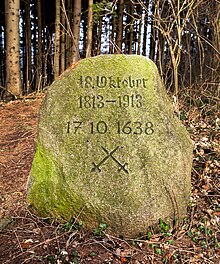Eiberg (Lipper Bergland)
| Eiberg | ||
|---|---|---|
|
Quarry on the western slope of the Eiberg |
||
| height | 230 m above sea level NN | |
| location | Vlotho , North Rhine-Westphalia , Germany | |
| Mountains | Lipper mountain country | |
| Coordinates | 52 ° 7 '59 " N , 8 ° 50' 58" E | |
|
|
||
The Eiberg is a mountain with a height of 230 m above sea level. NN in Vlotho . The mountain lies in the Vlotho district of Valdorf . The Linnenbeeke flows north . Naturally, it belongs to the Weser Uplands and the Lipper Mountains . To the east are the Große Selberg and the Bonstapel , to the west the Solterberg .
The 19 hectare Eiberg nature reserve has been designated since 1998. The beech and coniferous forest, a juniper heather also consisted of heather and the area of an abandoned quarry near the ridge are protected . The nature reserve is one of the last remaining heather areas in the Ravensberger Land .
fauna and Flora
Various rare species were found in the NSG. In 2012, for example, the bird species partridge , tree pipit and red backed shrike were breeding . Forest lizards , sand lizards and slow worms have been found among the reptiles . The insect species small heather grasshopper , small fire butterfly and wood ant . In addition to the juniper, there are also the rare plant species Borstgras , Dreizahn , medicinal thyme , Harz bedstraw , stemless thistle and golden thistle .
Protective measures in the nature reserve
The Eiberg was cut down in 1900 and then used as a sheep pasture until 1960. Much of the area was afforested in 1960. Since 1993, protective measures have been taken by the Ravensberg Biological Station , BUND and other conservationists for the remaining heath area in the NSG. In the process, the heather areas were freed from woody areas, apart from the juniper, several times. The approximately 6 m high rock wall in the quarry was cut free with a brush cutter every year . In 2008, 7,000 square meters of forest on the heather were cleared to enlarge the heather. The cleared area was sprinkled with heather from the Senne . A small fallow area on the heath was plagued, whereby the upper soil layer was removed with machines and removed. The grassland was fenced in with a sheep fence. In 2009, large heather and grassland areas were leased. Since then, these areas have been cultivated by a shepherd with heather sheep . These Heidschnucken had previously been bought by the Ravensberg Biological Station. The Heidschnucken herd was leased to the shepherd in a live cattle lease. The grassland and heather areas have been used extensively since 2009. According to the provisions of the contractual nature conservation according to the cultural landscape program, they will no longer be fertilized, furthermore only mowed after June 15 or grazed with a maximum of one livestock unit per hectare. In 2009, heather seedlings were also found on the plague and cleared area for the first time.
Memorial stone
On the Eiberg there is a memorial stone with time stamps. The date of October 18, 1813–1913 refers to the Battle of the Nations near Leipzig , in 1913 the stone was erected to commemorate this event 100 years ago. The date October 17, 1638 commemorates the battle of Vlotho and Valdorf in the Thirty Years War , which took place in the immediate vicinity of the Eiberges.
literature
- Heinz Lienenbecker: Comparative studies in some nature reserves in the Herford district (Eiberg, Kleiner Selberg, Linnenbeeke). Ber. Natural science Association f. Bielefeld u. Environment 51 (2013): 80-109
See also
Web links
- Nature reserve "Eiberg (Lipper Bergland)" (HF-040) in the specialist information system of the State Office for Nature, Environment and Consumer Protection in North Rhine-Westphalia
Individual evidence
- ^ Karl Großmann: History of the community Valdorf and its peasant communities . Valdorf 1955, p. 166 ff.




